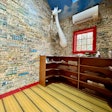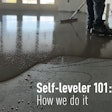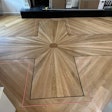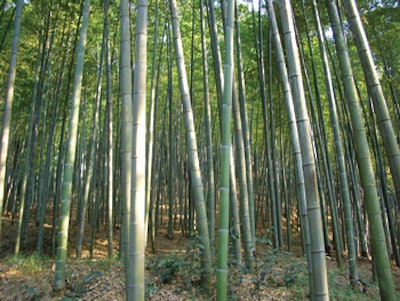
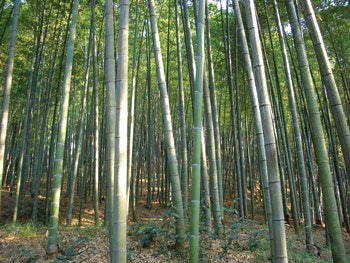 Photo courtesy of Cali Bamboo
Photo courtesy of Cali Bamboo
People in our industry have a lot of questions and concerns about bamboo. I've been selling and working with bamboo flooring since 2001, and I have been working directly with Chinese factories since 2004, but I'll be the first to admit that I still haven't figured bamboo out. It's a tricky material, and my experience with it has been a lot like my experience with wood-the more I learn, the more I realize I don't know. But I have had plenty of opportunities to see how things actually play out in the field-the good, the bad and the ugly-when people install different types and brands of bamboo flooring.
To start, I'd like to emphasize three points. First, the most important thing you have to remember about bamboo is that it is not wood. When you're dealing with bamboo, leave all of your wood habits and assumptions at the door. The only things it really has in common with wood are that it grows from the ground, and that it's hygroscopic.
 Raw bamboo canes that will be used for flooring. (Photos courtesy of Cali Bamboo.)
Raw bamboo canes that will be used for flooring. (Photos courtesy of Cali Bamboo.)
Second, strandwoven bamboo is really not like wood. It looks a little more like wood than traditional bamboo flooring, but the similarity goes only that far. Because it is infused with glue, strandwoven material has unique characteristics that make it even less like wood than traditional bamboo.
And third, not all bamboo is the same. There is a huge range in quality among the many different factories in China, and a huge range in the level of knowledge among the people who run those factories. Unfortunately, most bamboo flooring looks more or less the same out of the box, so buyers are easily tempted by low prices. In general, bamboo flooring is like anything else-you get what you pay for.
Overall, quality has improved in the bamboo flooring industry, and many of the quality problems that we see nowadays are from manufacturers who are cutting corners because of pressure from us, the buyers, to keep costs as low as possible. So, it's not really fair to blame the species for all of these problems, except insofar as it truly is a bit trickier to produce a quality flooring product out of bamboo than it is out of wood. Let's look at why.
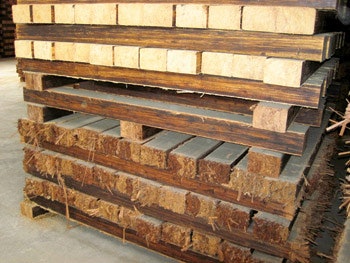 Compressed blocks of bamboo that will be turned into strand bamboo flooring.
Compressed blocks of bamboo that will be turned into strand bamboo flooring.
Bamboo's Biology
Bamboo differs from wood in some of its basic biological structures. Lignins are the natural resins that concentrate in the tissues of wood and bamboo that give them strength and density. In bamboo, those lignins are heavily concentrated in the vascular bundles. The strength of the fibers in these vascular bundles is incredible-it actually rivals steel. But the tissue between the vascular bundles, called the parenchyma, is much weaker than the tissues in most hardwood species.
In bamboo, the strong fibers are clustered more densely at the outer wall of the stalk and get less dense as you move inward. This is very different from wood, where the strong fibers are distributed more evenly throughout the log. In bamboo, the average density of the outer half of the wall may be twice that of the inner half.
To make bamboo flooring, rectangular strips are cut from the wall of the stalk, so each strip has a dense side and a less-dense side. The inner portion of the wall is more stable than the outer portion, so one side of the strip expands and contracts more than the other. So, every strip of bamboo is inherently imbalanced, and this is one of the biggest challenges manufacturers have to overcome.
 Types of bamboo construction include (from left): traditional horizontal construction, vertical construction (in bamboo's natural color), and strand bamboo. All photos this page courtesy of Cali Bamboo.
Types of bamboo construction include (from left): traditional horizontal construction, vertical construction (in bamboo's natural color), and strand bamboo. All photos this page courtesy of Cali Bamboo.
Bamboo is different from wood in another crucial way: It expands and contracts along its length (longitudinally). In most woods, longitudinal shrinkage doesn't really affect flooring installations, but in bamboo it is 2-3 tenths of a percent-enough to start being noticeable.
Another challenge is that the density and dimensional stability of bamboo change as you move up the stalk. Material taken from the base of the stalk will be less dense and more stable than material taken from higher up.
Now, in case things weren't complicated enough, here's a twist-along the length of the stalk, we have the same type of stability imbalance that we do through the thickness, but it's reversed! The soft inner wall is more stable than the outer wall when it comes to expansion and contraction across the grain, but it is actually less stable than the outer wall in the longitudinal direction. When a strip of bamboo goes into the kiln, it will shrink more across its width on the dense side, while at the same time it shrinks more along its length on the soft side. One side wants to cup while the other side wants to bow in the opposite direction. You can imagine the tension this creates.
Making Bamboo Flooring
With all of these inherent imbalances, one of the keys to making good bamboo flooring is to create uniformity through the plank by orienting the strips in ways that counteract or average out the imbalances.
In vertical-grain flooring, the strips on the left side of the plank are oriented with the denser portion toward the left. Then in the exact center of the plank, they switch directions and are oriented with the denser portion toward the right. If all of the strips were aligned the same way, the tendency of the soft sides to expand or contract more along the length of the plank would cause the planks to crook or "banana." By switching direction halfway across, they get the two sides to pull evenly on each other and cancel themselves out.
Horizontal bamboo is more dimensionally stable than vertical, because laminating the layers bonds the more stable and less stable portions of the strips together and helps cancel some of the movement. In my experience, you see fewer cupping claims on the horizontal material, I think in part because of this horizontal lamination, but also because of the way it is assembled in three layers. They always orient the hard side of the strips toward the surfaces, which creates a pattern that results in having more of the soft, stable material in the bottom half of the plank. So, as the humidity comes up from below and the plank starts to expand, the bottom expands less than it normally would relative to the top, counteracting some of the tendency to cup. In this case, with a wet subfloor, the imbalance of the bamboo actually works in our favor.
Janka Ratings & Bamboo
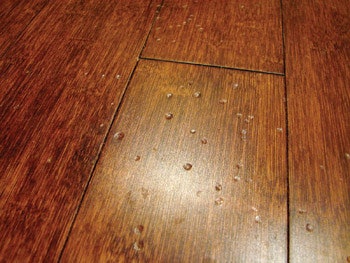 Claims about bamboo's Janka hardness can lead customers to be surprised by dents like these. (Photos courtesy of Doug Foucault, Hefeng USA/ECOfusion Flooring)
Claims about bamboo's Janka hardness can lead customers to be surprised by dents like these. (Photos courtesy of Doug Foucault, Hefeng USA/ECOfusion Flooring)
Hardness in bamboo is determined by a variety of factors, especially the age of the stalk. The tissues in bamboo harden as they grow older. Typically, horizontal bamboo gets a higher average Janka rating than vertical products because the soft sides of the strips are protected, whereas in the vertical material, they are exposed at the surface.
While age is important, be careful not to give too much credence to claims from some manufacturers that their products are superior because the material is older. Most of the moso bamboo used for flooring is harvested between its 5th and 6th years simply because it makes the most economic sense for the growers. After a point, older is no longer better-if you go much beyond the 6th year, the stalks become more brittle and are prone to cracking.
Other factors that determine hardness include altitude, latitude and soil conditions. Bamboo grown at higher elevations, further north, and in drier conditions tends to be more dense. In my experience, a majority of the bamboo flooring being sold by the premiere brands in the U.S. has material from the prime moso growing region in and around Zhejiang province in East Central China.
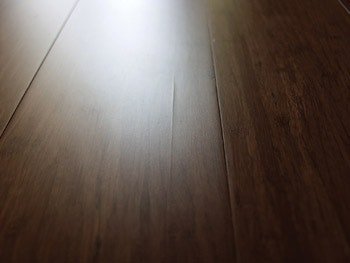 This engineered strandwoven board shows failure in a glue line.
This engineered strandwoven board shows failure in a glue line.
Where or when the bamboo was cut only tells a part of the story, because the genetics of the individual plants often play an important role in hardness. You can see fairly large variation in size and density even among stalks cut at the same age from the same farm, and even within the individual stalk there is significant variation in density. The better manufacturers buy only the best portion of the best stalks. This is one of the main reasons cost is a big determinant of quality in bamboo flooring.
For years we have seen bamboo flooring advertised as being harder than oak or maple. This is definitely true for strandwoven bamboo, but manufacturers consistently publish Janka hardness test values for traditional bamboo in the range of 1300-1800, like oak to hickory. Yet we've all heard from disappointed consumers who say that their bamboo floor doesn't hold up nearly as well as their old oak floors. So how can this be?
In some cases it may be inferior or immature raw material, but even quality raw material doesn't seem to hold up as advertised. I believe it goes back to the fact that the material's strength is in its vascular bundles, and the material between them is weak. When we test bamboo using a blunt object like a Janka ball, those strong fibers don't break. But when you hit bamboo with something sharp enough to cut through those fibers, there's little strength to resist the gouging. So, a rock in a shoe can make a much deeper gouge than it would in oak with the same Janka rating.
 Glue line failure in a traditional horizontal engineered floor.
Glue line failure in a traditional horizontal engineered floor.
Carbonization's Effects
Another reason consumers sometimes feel misled about the hardness of bamboo is that the marketing often fails to point out that carbonized color is on average 20 percent softer than the natural color, and the published Janka test results are usually results from the natural color. The carbonization process involves cooking the bamboo at very high temperatures, which literally caramelizes the bamboo's sugars. This weakens the material, making it softer and more brittle, and it increases the bamboo's capacity to absorb water, making it less dimensionally stable. This is true for both traditional and strandwoven bamboo.
The Newest Version: Strand
While traditional bamboo flooring may not be quite as tough as it's cracked up to be, its newer cousin, strand bamboo, is extremely hard and holds up well in high-traffic settings.
Strandwoven bamboo is made of small strands of bamboo that have been soaked in phenolic glue, re-dried, and then compressed into a composite. The result is a product similar to OSB except that the strands of bamboo run the full length of the plank, making it look more like natural wood. As a composite, it is much harder and, in most cases, more dimensionally stable than traditional bamboo flooring.
Some may doubt the statement that strand bamboo is more stable because many people have seen problems with it, but it's important to not confuse dimensional stability with reliability. Dimensional stability tells us how much the material will expand and contract, but it does not necessarily predict how well it will stay flat.
Because of the unique process involved and the glue that binds it together, strand bamboo can be difficult to dry and acclimate properly, can be prone to cracking, and is more susceptible to cupping than traditional bamboo when glued to a slab. And quality matters even more with strand bamboo than it does with traditional bamboo-the process and the glue are critical to its performance and there are many more ways to make mistakes and cut corners.
There are two types of manufacturing for strand bamboo: cold-press and hot-press. Manufacturers of both types claim that theirs is the superior method. Based on my testing and field experience, I'd say the jury is still out and that it really depends on the individual factory.
Engineered Issues
 Great caution must be taken with strandwoven bamboo glued directly over a slab due to its tendency to cup in that situation. (Photos courtesy of Doug Foucault, Hefeng USA/ECOfusion Flooring)
Great caution must be taken with strandwoven bamboo glued directly over a slab due to its tendency to cup in that situation. (Photos courtesy of Doug Foucault, Hefeng USA/ECOfusion Flooring)
In my experience, it's much more difficult to make a reliable engineered bamboo than it is to make a reliable engineered hardwood. Since making a bamboo top layer usually involves gluing together smaller strips, there are more opportunities for glue bond failure. However, more often than not, it's the bamboo itself that fails. When that bamboo top layer is locked by a glue bond to a layer of plywood (or other wood) running in the opposite direction, and it's not able to shrink, it has a tendency to tear itself apart more readily than most woods. Again, the weakness of the parenchyma is the problem. Most of the failures that you see with engineered bamboo are in out-of-warranty conditions. Properly made material used according to the manufacturer's guidelines is usually fine. But in my experience, when conditions get extreme, even well-made engineered bamboo is not as reliable as engineered hardwood flooring made with similar care.
Avoiding Mold
A problem you may have seen in traditional bamboo floors is grayish, streaky discoloration in some planks. This is fungus that has attacked the bamboo during the first few days after it was harvested. Raw bamboo rots quickly and has to be treated with borate solution within two days of being cut in order to prevent this. If mold has set in before the treatment, it may still be visible in the finished floor even though it has been killed.
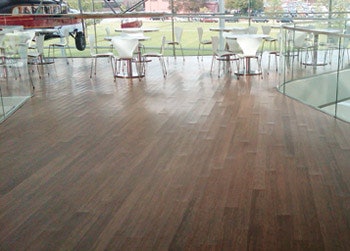 This solid strand floor was acclimated under normal conditions and then a large fountain was installed in the space; the increase in humidity caused the floor to expand in every direction, resulting in cupping as well as crushing and lifting at the ends.
This solid strand floor was acclimated under normal conditions and then a large fountain was installed in the space; the increase in humidity caused the floor to expand in every direction, resulting in cupping as well as crushing and lifting at the ends.
Unfortunately, I have seen cases where mold actually spread in the floor after it was installed, even under dry conditions. As a general rule of thumb, if you see this in a plank, it's probably safer not to install it. I have not seen this in carbonized bamboo, probably because of the heat from carbonization and because the darker color masks any mold. I have seen hints of mold in natural strandwoven bamboo, but it is much less visible and does not present the risk of spreading because the glue and curing process should kill any spores.
Other Job-Site Problems
There are some other common issues people encounter with bamboo on the job site. Most installers are in the habit of leaving expansion space along the sides of the planks but not where the boards end by the wall. With solid hardwood, you generally don't have to worry about it. With bamboo, because of its greater longitudinal instability, you do. You might also see the opposite problem when things get too dry, where the ends will pull away from each other. Gapping at the butt joints can happen with both traditional and strand bamboo.
RELATED: Avoid Common Callbacks with Imported Species
The growth in the popularity of strandwoven bamboo has been a big boost to the inspections industry; cupping claims on installations over concrete are a huge problem. Many strand jobs have mystified claims inspectors and glue manufacturers because the slab was within allowable limits and the vapor retarder was properly applied, yet still the floor cupped. It has led people to believe that strand bamboo is highly sensitive to moisture, but from what I've seen, strand bamboo has done just as well as similarly dense species of hardwood when installed over a crawlspace. The problem is that when it is installed on a slab, the density and the resin in strandwoven bamboo make it hard for the vapor to escape, causing moisture to slowly accumulate and condense on the surface of the slab. The strandwoven bamboo is itself a vapor barrier, but one that will absorb water slowly over time. This explains why some of these cupping claims over concrete are very slow to develop. The condensation of water under the strand bamboo also may account for the relatively large number of so-called "glue failures" that we've seen in these installations.
To prevent cupping, the perm rating of the vapor retarder would have to be equal to or lower than the perm rating of the strand bamboo itself, which is apparently extremely low, so you need an excellent vapor retarder. So, with strandwoven bamboo, it's even more important than with other materials to thoroughly test and seal the concrete, and to avoid installations where there is any sign of a moisture problem.
Another problem you may see with strandwoven flooring is a phenomenon I call "rippling," where you get tiny ripples or wrinkles in the face. Many strand installations have this problem, but it's often so subtle that the end-user hasn't noticed it. There are a couple of factors likely contributing to this. First, inconsistent or inadequate drying of raw material means that when the product acclimates at the job site, some strands are lifting or sinking relative to others. Second, there is a rebound effect-strands that have been compressed together have a tendency to want to bounce back against the direction of the press, especially with moisture.
The cracking problems that happen with engineered traditional and strand bamboo also show up with some solid strand products. Like with wood, drier conditions seem to bring this out more, but I've seen cracking develop in samples from lesser-quality manufacturers even at sea level in San Francisco. The causes of these cracks are often related to the same factors that cause the rippling-the rebound effect and inconsistent drying. But cracking can also sometimes be a symptom of a poor quality resin and/or improper curing.
Two other problems that you'll sometimes encounter in strandwoven installations are dimpling and edge crushing, which may look the same but are caused by different things. Dimpling usually occurs when the installer is using cleats that are too thick-strandwoven manufacturers recommend 18-gauge cleats, but many installers are in the habit of using 15.5-gauge cleats. Because this material is so dense, the fasteners will push it up and create a lump at the surface.
Edge crushing is a trickier problem. Strandwoven bamboo is very strong but brittle, and if the installer bangs his nailer too hard, he can create fractures in the side of the plank that may not be visible right away. If the planks later expand and pressure is exerted at that seam, the fractures get worse and can travel up through the face. You should be able to tell the difference between dimpling and edge crushing by the fact that on a dimpled floor, many of the lumps won't have cracks, and they will be visible right away.
The Takeaway Highlights
The truth is that if bamboo is properly made and installed, it can make a great floor. I have been involved in countless commercial and residential jobs that have gone off without a hitch and left the customer very satisfied. The strand bamboo floor that I put in my kitchen in 2006 still looks brand-new today.
To summarize, remember a few key pieces of advice:
1) Avoid using traditional bamboo in demanding settings where you have high traffic, big dogs, etc. It's really just not as hard as the Janka test results indicate.
2) Be sure to thoroughly acclimate and carefully measure the moisture content of strand bamboo before installation. You might be surprised how long it takes to acclimate properly.
3) If you plan to install strand bamboo on a slab on-grade, do careful testing to make sure there are no moisture issues, use the best vapor retarder possible, and be extra cautious with carbonized material.
4) Whenever possible, buy from a company with a good reputation, preferably one that has been importing bamboo flooring for many years. The quality problems and the corner-cutting some bamboo manufacturers engage in usually can't be seen with the naked eye, so you have to be careful. Like with anything else, be wary of a really good price.
The Moisture Reading Issue with BambooWe often hear complaints about huge variability in moisture readings with bamboo flooring. Moisture readings on bamboo have to be taken carefully, and even then it's hard to be sure you're getting accurate data. The first step is to make sure you are armed with the best information available from your moisture meter manufacturer. Some have done extensive testing and have correction guidelines, but the recommended corrections differ from one manufacturer to the next. In my conversations with meter manufacturers, even those that have done a lot of work on this have been a bit mystified and frustrated by the wide range of results they get. There are several reasons for this, among them variations in age and density among individual strips, variations in density from different strand glues and processes, and possible changes at the cellular level caused by heating, but we don't yet seem to have a clear handle on how important each of these factors might be. Make sure to verify with the meter manufacturer whether their correction numbers are for traditional or strand bamboo. For traditional bamboo, pin meters work fine, but always insert the pins parallel to the grain and to exactly the same depth. This helps make sure you avoid crossing a glue line, which can throw off the reading. For strandwoven bamboo, my experience suggests that you're best off using a surface meter; the factories in China that work with strandwoven products don't use pin meters at all. Drying bamboo at the factory is tricky, in part because it's so hard to measure the moisture content. Most of the factories don't dry the bamboo down to a target moisture content as we do with wood. Instead, they rely on a predetermined schedule, because checking the moisture content of individual strips can be misleading due to the density variation. Even with careful drying, consistent moisture content seems to be a problem for all manufacturers of strand bamboo. I have tested material from well-known brands with moisture content ranging from 6-15% right out of the box. With its extreme density and fibers sheathed in glue, acclimating strandwoven bamboo at the job site can take a long time. I would say as a general rule that strandwoven should be treated with the same caution with which you would treat the densest tropical hardwoods like ipé and cumaru. Acclimation times should be thought of in weeks, not days. — D.H. |
Grading BambooUnfortunately, there currently are no useful quality or grading standards for bamboo flooring. People in our industry who have been frustrated by the problems they've been seeing have asked NWFA to develop standards, and the NWFA has formed a committee, which I'm involved in, but it has proven to be a difficult task to come up with much beyond the HPVA rules that are already in existence for engineered flooring. These rules relate mainly to things like machining tolerances, moisture content, formaldehyde, and glue bond integrity, which are all important, but they don't speak to many of the issues explained here. In bamboo, you have tremendous variation in the quality of the raw material itself, and then there are many early steps in the manufacturing process that allow for human error and corner-cutting. In my opinion, to really create effective standards for bamboo, we would have to monitor the whole process from start to finish. |
The information in this article was adapted from a presentation at an NWFA Bamboo/Strand Workshop. For more information on NWFA classes, go to www.nwfa.org.

























